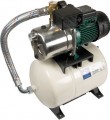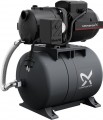Maximum performance
The maximum volume of water that the device can pump in a certain amount of time. It is one of the key specs of any pump because characterizes the volume of water with which the device can work. At the same time, it does not always make sense to pursue maximum performance — after all, it significantly affects the dimensions and weight of the unit.
Some formulas allow you to derive optimal performance values for different situations. So, if the pump is designed to supply water to water intake points, its minimum required performance should not be lower than the highest total flow rate; if desired, a margin of 20-30% can be added to this value. And for sewer models (see "Suitable for"), everything will depend on the volume of wastewater. More detailed recommendations for choosing a pump depending on performance can be found in special sources.
Maximum head
The maximum head generated by the pump. This parameter is most often indicated in meters, by the height of the water column that the unit can create — in other words, by the height to which it can supply water. You can estimate the pressure created by the pump using a simple formula: every 10 m of head corresponds to a pressure of 1 bar.
It is worth choosing a pump according to this parameter, taking into account the height to which it should supply water, as well as adjusting for losses and the need for pressure in the water supply. To do this, it is necessary to determine the difference in height between the water level and the highest point of water intake, add another 10 to 30 m to this figure (depending on the pressure that needs to be obtained in the water supply), and multiply the result by 1.1 — this will be the minimum pressure required.
Suction type
The main division in this parameter is related to whether the pump can remove air from the suction line. This, in turn, determines the features of starting the unit.
— Self-priming. Self-priming pumps include all pumps that do not require the complete absence of air in the suction line at startup — it is enough that the pump itself is filled with water. Accordingly, such models are less demanding and normally tolerate air entering the line. However, this requires a reliable design that can normally withstand water hammer, which accordingly affects the cost of the unit.
— Priming. Pumps with this device can only work normally when both the unit body and the suction line are filled with water. If air enters the line, it must be removed or the pump will not be able to start normally. Such models are not as convenient as self-priming ones; at the same time, they are noticeably cheaper, and with the normal quality of the water supply system, there is practically no significant difference between the two varieties.
Maximum liquid temperature
The highest temperature of water at which the pump is capable of operating normally. Usually, in most models this parameter is 35-40 °C — at high temperatures it is difficult to ensure effective cooling of the engine and moving parts, and in fact, such conditions are rare.
Maximum power
Rated power of the pump motor. The more powerful the engine, the higher the performance of the unit, usually, the greater the pressure, suction height, etc. Of course, these parameters largely depend on other features (primarily the pump type, see above); but models similar in design can be compared in terms of power.
Note that high power, usually, increases the size, weight and cost of the pump, and also implies high costs of electricity or fuel (see "Power source"). Therefore, it is worth choosing a pump according to this parameter taking into account the specific situation; more detailed recommendations can be found in special sources.
Noise level
The noise level produced by the pump during normal operation. For comparison, 50 decibels roughly corresponds to the noise in an office room, 60 dB to an average TV volume, 70 dB to a truck at a distance of about 8 m, 80 dB to traffic noise, and 90 dB to a scream. The lower the noise level, the more comfortable the use of the pump and the closer it can be placed to people. This parameter is especially important for models designed for indoor installation.
Protection class (IP)
An indicator that determines the degree of protection of dangerous (moving and current-carrying) parts of the hardware of the pump from adverse effects, namely solid objects and water. Since pumps, by definition, are used for pumping liquids, and many of them can normally pass quite large particles, in this case, we are talking about protection against moisture and foreign objects from outside.
The level of protection is usually indicated by a marking of the letters IP and two numbers, the first of which indicates protection against the effects of solid objects, and the second — against the ingress of water.
For the first digit, each value corresponds to the following protection values: 1 — protection against objects with a diameter of more than 50 mm (large body surfaces) 2 — against objects with a diameter of more than 12.5 mm (fingers, etc.) 3 — against objects more than 2.5 mm (most tools) 4 — against objects larger than 1 mm (virtually all tools, most wires) 5 — dust-proof (total protection against contact; dust can enter, but does not affect the operation of the device) 6 — dust-proof (case with full dust protection and contact).
For the second digit: 1 — protection against vertically falling drops of water 2 — against drops of water with a deviation of up to 15° from the vertical axis of the device 3 — against drops of water with a deviation of up to 60° from the vertical axis of the device (rain) 4 — against splashes from any direct...ion 5 — from jets from any direction 6 — from sea waves or strong water jets 7 — short-term immersion to a depth of up to 1 m (without the possibility of continuous operation in immersed mode) 8 — long-term immersion to a depth of more than 1 m (with the possibility of permanent operation) in immersed mode).
Note that in some cases one of the numbers can be replaced by the letter X — this means that official certification for the corresponding parameter has not been carried out. In pumps, X is usually put in place of the first digit, because. a high degree of moisture resistance (and for submersible models, for example, it must, by definition, correspond to 8) means a high degree of protection against solid contaminants.
Country of origin
Country of origin of the brand under which the pump is marketed.
There are many stereotypes related to how the origin of goods from a particular country affects their quality. However, these stereotypes are unfounded. Firstly, this paragraph does not indicate the actual place of production of the unit, but the "homeland" of the trademark (or the location of the manufacturer's headquarters); production facilities may be located in another country. Secondly, the actual quality of the product depends not so much on geography, but on the organization of processes within a particular company. So when choosing, it is best to focus not so much on the "nationality" of the pump, but on the overall reputation of a particular brand. And paying attention to the country of origin makes sense if you fundamentally want (or do not want) to support a manufacturer from a certain state.
Pump housing material
The material from which the pump housing is made. It is a structural element in which the working mechanism (impeller or auger) is installed. Note that the motor casing can be made of a different material — this is not important in this case; and in water pumps with the engine (see “Power source”), we are talking about the casing of the pump itself, and not about the support frame in which it is fixed.
The following options are most popular nowadays:
— Plastic. Inexpensive material that perfectly resists moisture and is not subject to corrosion. However, the reliability of plastic as a whole is not very high; the exception is special high-strength grades, but they are extremely rare in pumps (when strength is needed, metals are usually used). So plastic housing is mainly equipped with relatively simple and affordable models that are not designed for serious loads.
— Cast iron. An extremely popular material nowadays: cast iron is strong, reliable, durable and at the same time has a relatively low cost. However, in terms of corrosion resistance, this material is inferior to stainless steel (see below). Nevertheless, subject to the rules for operating the pump, the service life of the cast-iron housing is not inferior to the service life of most of the main components of the unit. Also note that such cases are quite massive, which makes transportation difficult; however, in some cases, a large weight is an advantage: it helps to dampen vibrati...ons.
— Stainless steel. By the name, one of the key advantages of stainless steel is high resistance to corrosion — and, accordingly, reliability and durability. On the other hand, this material also costs a little more than the same cast iron. The weight of such housing is somewhat less — this, again, can be both an advantage and a disadvantage, depending on the situation.
— Aluminium. Premium material. The aluminium alloys used in today's pumps are light, strong, durable, and virtually impervious to moisture, but cost accordingly.
— Brass. A fairly rare option found in some models of surface pumps. Brass is strong enough, reliable and resistant to moisture, but in most cases, it does not have key advantages over the same stainless steel or aluminium but costs a little more.
— Bronze. Another material similar to the brass described above is durable and practical but rarely used.
— Ceramics. A material found exclusively in sewage pumps in the form of toilet bowls (see "Pump design"). Most often, ceramics means vitreous china or more expensive and durable vitreous china — that is, the same materials as in ordinary toilets without built-in pumps.

